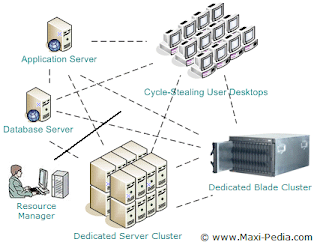These two terms differ as Information architecture describes the planning of the use of the IT systems, whereas Information infrastructure describes the actual implementation of the processes. Despite these differences, they both are similar as architecture is the plan for the future infrastructure - they both interrelate.
2. An organisation can implement a solid information architecture by incorporating strong and effective security processes. For example back up processes, security software for information protection and disaster recovery tools.
3. The five requirement characteristics of infrastructure architecture include:
Flexibility: Ensures that the IT systems in place have the ability to adapt and change to the businesses changing environment.
Scalability: Ensures the ability to grow with the business, allowing for increase in numbers/demand.
Availability: Systems must have effective and easy accessibility.
Reliability: Ensures all systems are running correctly.
Performance: Ensures all systems are running efficiently and effectively, measuring how quickly a system performs certain processes/transactions.
4. Service oriented architecture is a concept for a business-driven IT architectural approach that supports integrating a business as linked, repeatable tasks or services. The value of SOA for a business is that it enables the business to adapt efficiently and effectively to the ever changing business needs. It can also allow for the re-use of applications many times for different tasks, making development cheaper and more flexible.
5. An event are the IT systems which detect threats and opportunities within a business. Their job is to alert the individuals in the business whose job it is to act on the information.
6. A service is a software product which can be used numerous times in order to boost productivity within a business. An example of services used within a business include credit check or a process payment.
7. The following emerging technologies can be used to increase the performance of a business and can help to utilise their infrastructure more effectively:
Interoperability - the capability of two or more computer systems to share data and resources.
Loose coupling - building a connection between servers which can be added or removed easily.
More about loose coupling
Virtualisation - A framework of dividing the resources of a computer into multiple execution environments. Allows for the increase in physical resources to maximise the investment in hardware.
Benefits of virtualisation
Grid computing - The combination of widely dispersed network computing, storage and network systems coordinated to deliver improved performance and at a higher quality.
3. The five requirement characteristics of infrastructure architecture include:
Flexibility: Ensures that the IT systems in place have the ability to adapt and change to the businesses changing environment.
Scalability: Ensures the ability to grow with the business, allowing for increase in numbers/demand.
Availability: Systems must have effective and easy accessibility.
Reliability: Ensures all systems are running correctly.
Performance: Ensures all systems are running efficiently and effectively, measuring how quickly a system performs certain processes/transactions.
4. Service oriented architecture is a concept for a business-driven IT architectural approach that supports integrating a business as linked, repeatable tasks or services. The value of SOA for a business is that it enables the business to adapt efficiently and effectively to the ever changing business needs. It can also allow for the re-use of applications many times for different tasks, making development cheaper and more flexible.
5. An event are the IT systems which detect threats and opportunities within a business. Their job is to alert the individuals in the business whose job it is to act on the information.
6. A service is a software product which can be used numerous times in order to boost productivity within a business. An example of services used within a business include credit check or a process payment.
7. The following emerging technologies can be used to increase the performance of a business and can help to utilise their infrastructure more effectively:
Interoperability - the capability of two or more computer systems to share data and resources.
Loose coupling - building a connection between servers which can be added or removed easily.
More about loose coupling
Virtualisation - A framework of dividing the resources of a computer into multiple execution environments. Allows for the increase in physical resources to maximise the investment in hardware.
Benefits of virtualisation
Grid computing - The combination of widely dispersed network computing, storage and network systems coordinated to deliver improved performance and at a higher quality.

No comments:
Post a Comment